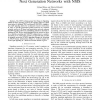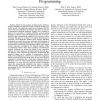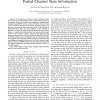ICC
2009
IEEE
14 years 6 months ago
2009
IEEE
—The Domain Name Service (DNS) provides a critical function in directing Internet traffic. Defending DNS servers from bandwidth attacks is assisted by the ability to effectively...
ICC
2009
IEEE
14 years 6 months ago
2009
IEEE
Relay selection for cooperative communications has attracted considerable research interest recently. While several criteria have been proposed for selecting one or more relays an...
ICC
2009
IEEE
14 years 6 months ago
2009
IEEE
—The IETF working group Next Steps in Signaling (NSIS) develops signaling protocols for Quality-of-Service (QoS) reservations or dynamic NAT and firewall (NAT/FW) configuration...
ICC
2009
IEEE
14 years 6 months ago
2009
IEEE
—In this paper, we study the problem of computing the supported QoS from a source to a destination with multiple additive constraints. The problem has been shown to be NP-complet...
ICC
2009
IEEE
14 years 6 months ago
2009
IEEE
A graph-based framework for dynamic fractional frequency reuse (FFR) in multi-cell OFDMA networks is proposed in this work. FFR is a promising resource allocation technique that c...
ICC
2009
IEEE
14 years 6 months ago
2009
IEEE
—Fueled by the promises of high spectral efficiency, adaptive OFDMA has attracted enormous research interests over the last decade. The significant capacity gain of adaptive OF...
ICC
2009
IEEE
14 years 6 months ago
2009
IEEE
—With the opening of the 60 GHz spectrum for WLANs, there has been a great deal of interest in academia and industry on how best to exploit the more than 5 GHz of available bandw...
ICC
2009
IEEE
14 years 6 months ago
2009
IEEE
—In this paper, we propose a joint precoding scheme for both the base station (BS) and relay station (RS) to increase the ergodic capacity of downlink non-regenerative multiple-i...
ICC
2009
IEEE
14 years 6 months ago
2009
IEEE
—In this paper, we present a composite hypothesis testing approach for cooperative spectrum sensing. We derive the optimal likelihood ratio test (LRT) statistic based on the Neym...
ICC
2009
IEEE
14 years 6 months ago
2009
IEEE
—In the conventional two-way relay channel, two sources exchange information with help from a relay. We introduce a generalized two-way relay channel where each source additional...



